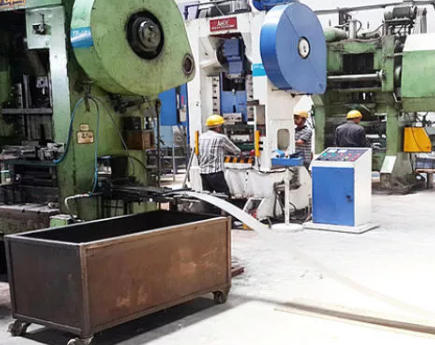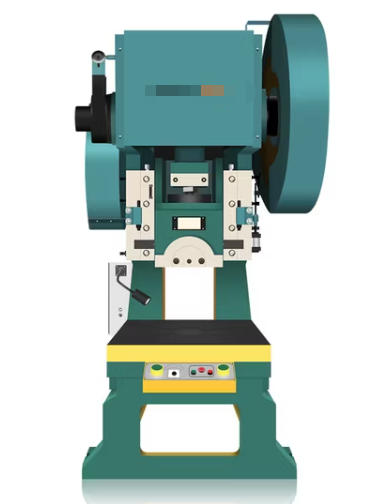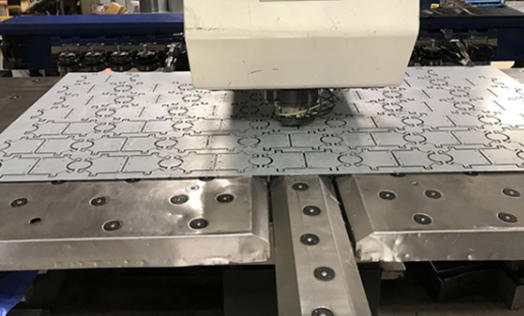Views: 222 Author: Rebecca Publish Time: 2025-11-17 Origin: Site









Content Menu
● Introduction to Punch Press Technology
● The Importance of Punch Presses in the Tableware Industry
● Operational Principles of a Punch Press Machine
● Key Components of a Punch Press Machine
>> 1. Frame
>> 7. Controller and Automation Interface
>> 9. Lubrication and Cooling System
● Types of Punch Press Machines Used in Tableware Production
● Performance Optimization and Troubleshooting
>> Troubleshooting Common Problems
● Integration With Smart Factory Systems
● Sustainability and Energy Efficiency
● Future Trends in Punch Press Technology
● FAQ
>> 1. What kind of metal is most commonly processed in punch presses for tableware?
>> 2. How can a punch press improve production efficiency?
>> 3. What maintenance schedule is best for high-output utensil factories?
>> 4. Are punch press machines environmentally friendly?
>> 5. What factors influence the lifespan of a punch press machine?
In the competitive world of tableware manufacturing, precision, efficiency, and durability define success. Factories that produce stainless-steel cutlery, aluminum serveware, or decorative dishes rely on heavy-duty machines that can shape materials quickly and consistently. Among these machines, the punch press stands as one of the most vital tools in the production process.
A punch press machine transforms flat sheets of metal into functional, refined products used in everyday life. From common spoons and forks to artistically designed trays and kitchen lids, the perfect balance between cutting power and mechanical accuracy determines both the design and quality of the final product.
This article explains the key components of a punch press machine, its role in the utensil manufacturing process, and how technological advances are making these machines more efficient and environmentally friendly.

A punch press machine is an industrial forming tool that uses compressive force to cut, emboss, punch, or shape sheet metal. In tableware factories, these machines perform the preliminary shaping of cookware and utensil blanks before the items move on to polishing, trimming, and finishing.
The principle behind a punch press is simple yet powerful. A punch, driven by mechanical or hydraulic energy, pushes material into a die cavity, shaping the sheet into the desired form. By carefully controlling this force, manufacturers can maintain dimensional accuracy and improve production efficiency, even when producing thousands of identical pieces per hour.
In modern factories, punch press machines are equipped with electronic sensors, programmable logic controllers (PLCs), and CNC automation systems that ensure millimeter-level accuracy. This automation has greatly improved the repeatability of forming spoons, forks, and knives—critical when products must meet international quality and design standards.
Metal tableware production is a series of complex operations involving cutting, forming, pressing, polishing, and finishing. The punch press acts as the foundation of this chain by performing the shaping tasks that define a utensil's form and weight balance.
Manufacturers depend on punch presses for several core functions:
- Cutting raw stainless-steel or aluminum sheets into shapes like spoon blanks or tray outlines.
- Punching holes or forming ergonomic handle designs on utensils.
- Embossing decorative surfaces on premium or branded kitchenware items.
- Pre-forming circular or rectangular patterns for automatic deep drawing presses.
For high-end tableware, where even minor surface imperfections are unacceptable, the precision of the punch press ensures consistent results with minimal waste. Moreover, with growing market demand for customization, advanced CNC punch presses allow quick changeovers between designs without manual retooling.
At its core, the punch press operates on a straightforward mechanical principle: the conversion of rotary motion into linear force. The machine applies intense downward pressure to a metal sheet placed between the punch and die. When the punch makes contact, part of the metal is sheared or formed into the die cavity, creating precise shapes.
1. Material Loading: Coiled or sheet metal is loaded onto the feed table or automated feeder.
2. Positioning and Alignment: Sensors detect and align the material for accuracy.
3. Punching or Forming: The ram drives the punch into the die, shaping or perforating the sheet.
4. Ejection: The finished blank is separated from scrap and removed automatically.
5. Cycle Repeat: The machine repeats the operation at controlled intervals.
In utensil production, several punch presses may work in a line—first cutting, then piercing or trimming edges. This layered process maintains high production throughput while ensuring every product shape remains consistent.
Each section of a punch press contributes to its overall performance, production stability, and precision. A well-designed press can operate continuously for years, provided all components function harmoniously.
The frame provides the primary structural support for the punch press. Built from cast iron or heavy-duty welded steel, it holds all major parts, such as the ram, clutch, bolster plate, and flywheel, in exact alignment.
In utensil factories, where high tonnage is necessary for stainless steel forming, the frame's rigidity prevents misalignment under stress. Larger presses may include reinforcement ribs or stress-relief structures to reduce vibration, enabling smoother operation and longer tool life.
The ram delivers the downward punching action. Mounted vertically, it carries the punch tool and applies pressure to form or cut the workpiece. Its movement may be mechanically or hydraulically controlled.
Advanced servo-driven rams in modern machines allow precise force adjustment, essential for different material thicknesses. In tableware production, a controlled stroke ensures uniform depth when forming equipment like trays or bowl handles, reducing the risk of cracks or uneven edges.
The combination of punch and die defines the geometry of the finished product. The punch cuts or presses the metal, while the die provides the cavity or resistance needed for shaping.
Types of dies commonly used in utensil manufacturing include:
- Blanking Dies: For cutting outlines of spoons, forks, or knife handles.
- Piercing Dies: For punching decorative holes or slots.
- Embossing Dies: For imprinting brand logos or ornamental designs.
- Progressive Dies: For sequentially forming multiple features with each press cycle.
High-speed presses often use hardened carbide tooling or high-chromium steel dies to handle the repetitive impact of dense metals like stainless steel.
Situated on the press bed, the bolster plate acts as the mounting base for the die assembly. Its thickness and hardness are critical to absorbing the force created during punching.
In high-production environments, bolster plates are precision machined and bolted securely to prevent any deflection. Any unevenness could distort utensil shapes, especially for thin sheet metal products like flatware and lids.
The clutch engages the flywheel to transfer energy into the crankshaft, while the brake halts movement when needed. Timely coordination of these systems ensures each stroke delivers the correct pressure and stops safely after completion.
Mechanical presses use friction or pneumatic clutches, while modern models often employ electromagnetic systems for silent, fast engagement. This reduces wear on internal components and guarantees operator safety during operation.
The flywheel stores rotational energy and channels it through the crankshaft to convert rotary motion into linear movement. A balanced and well-maintained flywheel is essential for consistent punching velocity.
Energy-efficient designs now utilize twin flywheels for smoother energy distribution, particularly in presses handling thicker materials like heavy-duty cooking utensil blanks. Uniform motion prevents material tearing and enhances edge quality.
The control panel allows operators to manage stroke length, speed, and punching sequence. Modern CNC punch presses include user-friendly interfaces that show real-time data such as press force, die alignment, tonnage recording, and production count.
Automation integration enables synchronization with robotic feeding systems, so operators can program multiple production cycles at once—ideal for factories manufacturing items with varied dimensions or styles.
Depending on the type of press, the power system may use an electric motor (mechanical press) or a hydraulic pump and cylinder (hydraulic press).
Hydraulic systems are valued for their flexibility and smooth action, while electric presses deliver precise control and reduced maintenance. In utensil manufacturing, hybrid servo-hydraulic configurations often achieve both high speed and fine control, lending extra versatility for producing detailed designs.
Continuous lubrication maintains smooth mechanical function by reducing heat and friction. Automatic lubrication systems distribute oil to bearings, slides, and moving joints according to timed intervals.
Some machines also include cooling circuits that direct airflow or coolant to critical areas, preserving tool hardness and preventing heat-induced distortions during long shifts.
Ensuring operator safety is fundamental in punch press operation. Common safety features include:
- Light curtains and sensor barriers that halt motion when interrupted.
- Enclosed guarding over moving parts.
- Two-hand control systems to keep hands clear during operation.
- Automatic overload protection that shuts the machine off if it exceeds pressure limits.
These features protect both the workforce and the costly tooling from accidental damage.

The choice of punch press depends on production volume, material type, and design complexity.
1. Mechanical Punch Press: Known for high-speed operation. Ideal for repetitive blanking and trimming of utensils.
2. Hydraulic Punch Press: Offers controlled pressure, suitable for forming shapes or embossing.
3. Servo-Driven Punch Press: Combines the advantages of both systems and allows programmable stroke profiles.
4. CNC Turret Punch Press: Features a rotating turret carrying multiple punch tools for diverse patterns and rapid design changes without manual intervention.
Factories producing diverse dinnerware sets often prefer CNC turrets, as one machine can produce several designs from the same material batch.
A punch press operates continuously under high stress, making preventive maintenance a core aspect of performance.
- Schedule weekly calibration of die alignment.
- Inspect electrical connections and control systems regularly.
- Replace worn punches or dies before visible defects appear.
- Check bolting torque on the bolster plate.
- Verify lubrication distribution systems are functioning properly.
- Burr Formation on Edges: Indicates dull punch or misaligned die.
- Vibration or Noise: Often due to loosened joints or frame imbalance.
- Oil Leakage: Common in hydraulic systems with worn seals.
- Inconsistent Stroke Pressure: May result from irregular clutch engagement or electrical malfunction.
Proper inspection, calibration, and operator training prevent costly production downtime and ensure consistent utensil quality.
As Industry 4.0 advances, smart tableware factories are incorporating networked punch presses that communicate with enterprise resource planning (ERP) systems.
Each press unit can report production data in real time, including cycle counts, force metrics, and energy use. Predictive maintenance algorithms analyze vibration sensors and power draw, allowing technicians to identify potential failures before they occur.
Machine learning and data-driven optimization now enable utensil manufacturers to balance workload between machines, ensuring efficient operation and minimal idle time.
Modern consumers increasingly value sustainable production. For tableware manufacturers, optimizing punch press processes directly reduces material and energy waste.
Key sustainability practices include:
- Using optimized cutting software to minimize scrap.
- Recyclable lubrication oils and hydraulic fluids.
- Servo-driven systems that consume less electricity than constant-speed motors.
- Recycling metal offcuts and reusing them within the production cycle.
By combining technological innovation with eco-conscious operations, manufacturers both protect the environment and reduce production costs.
The future of punch press machinery for tableware production lies in greater automation and precision. Robotics will further streamline sheet feeding, part removal, and die exchange. Digital twins of punch presses are being developed to simulate operations virtually before actual manufacturing begins.
Additionally, AI-enhanced press controllers will automatically adjust force based on real-time sensor data, improving consistency across different metal lots. With synchronized lines incorporating polishing, forming, and stamping, the entire utensil manufacturing process will become faster, cleaner, and smarter.
Punch press machines stand at the heart of modern tableware manufacturing, serving as the primary tool for shaping and cutting metal sheets into the utensils and cookware used worldwide. Each component—from the frame to the control panel—contributes to the accuracy, efficiency, and safety that define contemporary utensil production.
With advancements in automation, energy efficiency, and digital monitoring, punch presses continue to evolve alongside the growing demands of global markets. Understanding their key components not only empowers engineers to maintain performance but also ensures that every spoon, fork, and dish produced meets the highest standards of quality, design, and sustainability.

Stainless steel is the primary choice due to its corrosion resistance and durability. Aluminum and nickel-plated steel are also popular for lighter or decorative pieces.
Advanced presses equipped with CNC or servo systems perform multiple operations in one cycle, reducing manual setup time and improving consistency in output.
A structured schedule should include daily visual checks, weekly lubrication audits, and monthly die sharpening to maintain productivity and reduce unplanned downtime.
Modern models use energy-saving motors, recyclable lubricants, and smart waste management systems that lower power consumption and metal waste.
Material hardness, operating pressure, regular maintenance, and environmental conditions all play key roles. With proper care, a punch press can operate efficiently for decades.
Why The Right Punch Press Machine Is Crucial for High-Quality Tableware Production?
Punch Press Machines: The Backbone of Efficient Cutlery Production
How To Choose Between Manual And Automatic Punch Press Machines?
Best Punch Press Machines for Small And Large-Scale Manufacturers
Top Manufacturers of Punch Press Machines for The Tableware Industry
What Are The Key Benefits of Investing in A Punch Press Machine for Your Factory?
How Punch Press Machines Are Revolutionizing The Cutlery Industry?
The Role of Punch Press Machines in Modern Kitchenware Production Lines
Punch Press Machine Vs. Turret Punch Press: What's The Difference?
